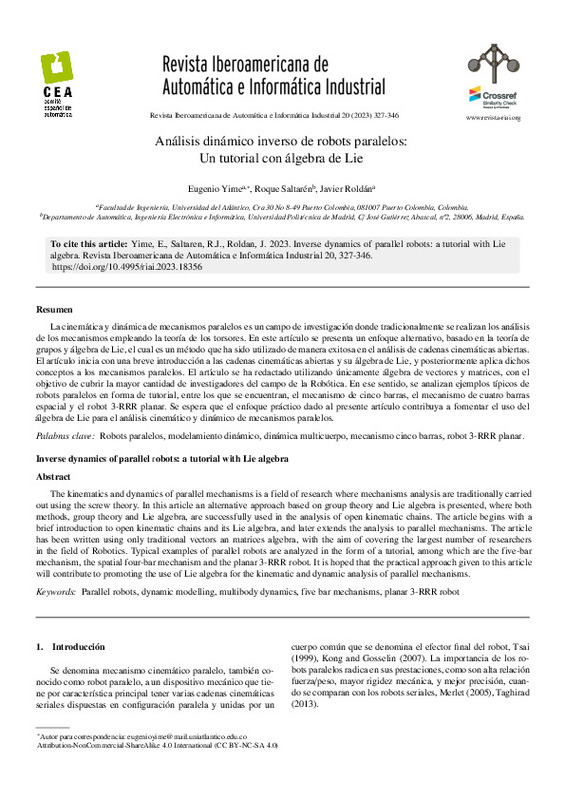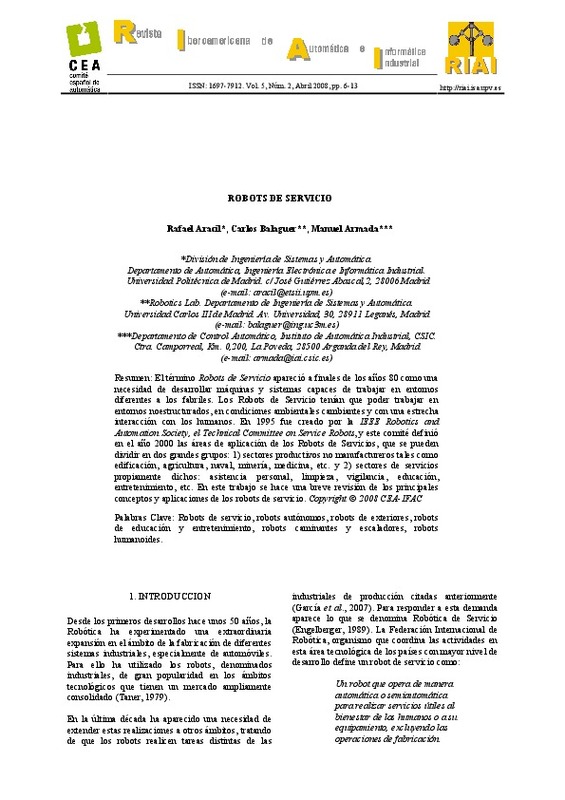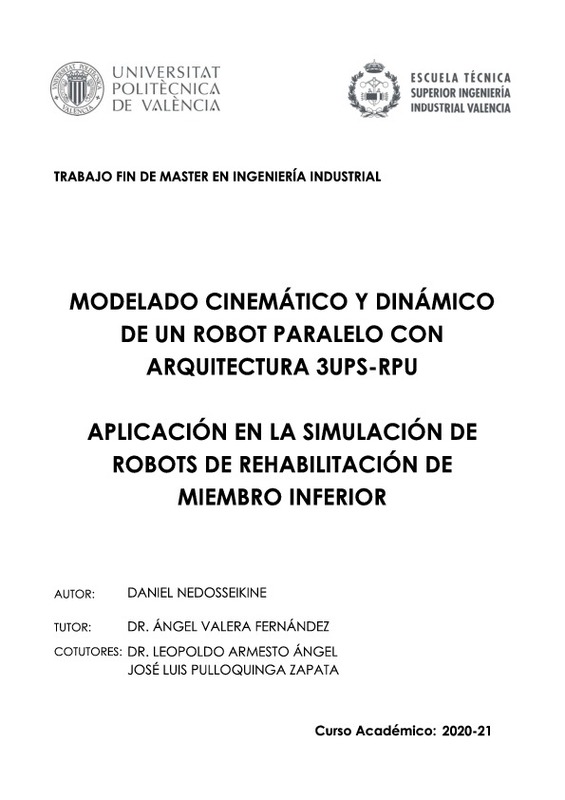JavaScript is disabled for your browser. Some features of this site may not work without it.
Buscar en RiuNet
Listar
Mi cuenta
Estadísticas
Ayuda RiuNet
Admin. UPV
Análisis dinámico inverso de robots paralelos: Un tutorial con álgebra de Lie
Mostrar el registro sencillo del ítem
Ficheros en el ítem
| dc.contributor.author | Yime, Eugenio
|
es_ES |
| dc.contributor.author | Saltarén, Roque Jacinto
|
es_ES |
| dc.contributor.author | Roldán Mckinley, Javier Agustin
|
es_ES |
| dc.date.accessioned | 2023-11-07T13:01:22Z | |
| dc.date.available | 2023-11-07T13:01:22Z | |
| dc.date.issued | 2023-09-29 | |
| dc.identifier.issn | 1697-7912 | |
| dc.identifier.uri | http://hdl.handle.net/10251/199436 | |
| dc.description.abstract | [EN] The kinematics and dynamics of parallel mechanisms is a field of research where mechanisms analysis are traditionally carried out using the screw theory. In this article an alternative approach based on group theory and Lie algebra is presented, where both methods, group theory and Lie algebra, are successfully used in the analysis of open kinematic chains. The article begins with a brief introduction to open kinematic chains and its Lie algebra, and later extends the analysis to parallel mechanisms. The article has been written using only traditional vectors an matrices algebra, with the aim of covering the largest number of researchers in the field of Robotics. Typical examples of parallel robots are analyzed in the form of a tutorial, among which are the five-bar mechanism, the spatial four-bar mechanism and the planar 3-RRR robot. It is hoped that the practical approach given to this article will contribute to promoting the use of Lie algebra for the kinematic and dynamic analysis of parallel mechanisms. | es_ES |
| dc.description.abstract | [ES] La cinematica y dinámica de mecanismos paralelos es un campo de investigación donde tradicionalmente se realizan los análisis de los mecanismos empleando la teoría de los torsores. En este artículo se presenta un enfoque alternativo, basado en la teoría de grupos y álgebra de Lie, el cual es un método que ha sido utilizado de manera exitosa en el análisis de cadenas cinemáticas abiertas. El artículo inicia con una breve introducción a las cadenas cinemáticas abiertas y su algebra de Lie, y posteriormente aplica dichos conceptos a los mecanismos paralelos. El artículo se ha redactado utilizando unicamente álgebra de vectores y matrices, con el objetivo de cubrir la mayor cantidad de investigadores del campo de la Robótica. En ese sentido, se analizan ejemplos típicos de robots paralelos en forma de tutorial, entre los que se encuentran, el mecanismo de cinco barras, el mecanismo de cuatro barras espacial y el robot 3-RRR planar. Se espera que el enfoque practico dado al presente artículo contribuya a fomentar el uso del algebra de Lie para el análisis cinemático y dinámico de mecanismos paralelos. | es_ES |
| dc.language | Español | es_ES |
| dc.publisher | Universitat Politècnica de València | es_ES |
| dc.relation.ispartof | Revista Iberoamericana de Automática e Informática industrial | es_ES |
| dc.rights | Reconocimiento - No comercial - Compartir igual (by-nc-sa) | es_ES |
| dc.subject | Planar 3-RRR Robot | es_ES |
| dc.subject | Parallel robots | es_ES |
| dc.subject | Dynamic modelling | es_ES |
| dc.subject | Multibody dynamics | es_ES |
| dc.subject | Five bar mechanisms | es_ES |
| dc.subject | Mecanismo cinco barras | es_ES |
| dc.subject | Modelamiento dinámico | es_ES |
| dc.subject | Robots paralelos | es_ES |
| dc.subject | Robot 3-RRR planar | es_ES |
| dc.subject | Dinámica multicuerpo | es_ES |
| dc.title | Análisis dinámico inverso de robots paralelos: Un tutorial con álgebra de Lie | es_ES |
| dc.title.alternative | Inverse dynamics of parallel robots: A tutorial with Lie algebra | es_ES |
| dc.type | Artículo | es_ES |
| dc.identifier.doi | 10.4995/riai.2023.18356 | |
| dc.rights.accessRights | Abierto | es_ES |
| dc.description.bibliographicCitation | Yime, E.; Saltarén, RJ.; Roldán Mckinley, JA. (2023). Análisis dinámico inverso de robots paralelos: Un tutorial con álgebra de Lie. Revista Iberoamericana de Automática e Informática industrial. 20(4):327-346. https://doi.org/10.4995/riai.2023.18356 | es_ES |
| dc.description.accrualMethod | OJS | es_ES |
| dc.relation.publisherversion | https://doi.org/10.4995/riai.2023.18356 | es_ES |
| dc.description.upvformatpinicio | 327 | es_ES |
| dc.description.upvformatpfin | 346 | es_ES |
| dc.type.version | info:eu-repo/semantics/publishedVersion | es_ES |
| dc.description.volume | 20 | es_ES |
| dc.description.issue | 4 | es_ES |
| dc.identifier.eissn | 1697-7920 | |
| dc.relation.pasarela | OJS\18356 | es_ES |
| dc.description.references | Briot, S., Khalil,W., 2015. Dynamics of Parallel Robots: From Rigid Bodies to Flexible Elements. Springer. https://doi.org/10.1007/978-3-319-19788-3 | es_ES |
| dc.description.references | Featherstone, R., 2008. Rigid Body Dynamics Algorithms. Springer. https://doi.org/10.1007/978-1-4899-7560-7 | es_ES |
| dc.description.references | Gallardo, J., Rico, J. M., Frisoli, A., Checcacci, D., Bergamasco, M., 2003. Dynamics of parallel manipulators by means of screw theory. Mechanism and Machine Theory 38, 1113-1131. https://doi.org/10.1016/S0094-114X(03)00054-5 | es_ES |
| dc.description.references | Gallardo-Alvarado, J., 2016. Kinematic Analysis of Parallel Manipulators by Algebraic Screw Theory. Springer. https://doi.org/10.1007/978-3-319-31126-5 | es_ES |
| dc.description.references | Gallardo-Alvarado, J., Gallardo-Razo, J., 2022. Mechanisms: Kinematic Analysis and Applications in Robotics. Elsevier. | es_ES |
| dc.description.references | Gogu, G., 2008. Structural Synthesis of Parallel Robots: Part 1: Methodology. Springer. https://doi.org/10.1007/978-1-4020-5710-6 | es_ES |
| dc.description.references | Gogu, G., 2009. Structural Synthesis of Parallel Robots: Part 2: Translational Topologies with Two and Three Degrees of Freedom. Springer. | es_ES |
| dc.description.references | Gogu, G., 2010. Structural Synthesis of Parallel Robots: Part 3: Topologies with Planar Motion of the Moving Platform. Springer. https://doi.org/10.1007/978-90-481-9831-3 | es_ES |
| dc.description.references | Gogu, G., 2012. Structural Synthesis of Parallel Robots: Part 4: Other Topologies with Two and Three Degrees of Freedom. Springer. https://doi.org/10.1007/978-94-007-2675-8 | es_ES |
| dc.description.references | Gogu, G., 2014. Structural Synthesis of Parallel Robots: Part 5: Basic Overconstrained Topologies with Sch¨onflies Motions. Springer. https://doi.org/10.1007/978-94-007-7401-8 | es_ES |
| dc.description.references | Haug, E. J., 1989. Computer Aided Kinematics and Dynamics of Mechanical Systems. Pearson College Div. | es_ES |
| dc.description.references | Kim, J., Park, F., 2001. Direct kinematic analysis of 3-rs parallel mechanisms. Mechanism and Machine Theory 36 (10), 1121-1134. https://doi.org/10.1016/S0094-114X(01)00042-8 | es_ES |
| dc.description.references | Kong, X., Gosselin, C. M., 2007. Type Synthesis of Parallel Mechanisms. Springer. https://doi.org/10.1115/DETC2006-99628 | es_ES |
| dc.description.references | Lynch, K. M., Park, F. C., 2017. Modern Robotics: Mechanics, Planning, and Control. Cambridge University Press. | es_ES |
| dc.description.references | Merlet, J. P., 2004. Solving the forward kinematics of a gough-type parallel manipulator with interval analysis. The International Journal of Robotics Research 23 (3), 221-235. https://doi.org/10.1177/0278364904039806 | es_ES |
| dc.description.references | Merlet, J. P., 2005. Parallel Robots. Springer. | es_ES |
| dc.description.references | Morell, A., Tarokh, M., Acosta, L., 2013. Solving the forward kinematics problem in parallel robots using support vector regression. Engineering Applications of Artificial Intelligence 26 (7), 1698-1706. https://doi.org/10.1016/j.engappai.2013.03.011 | es_ES |
| dc.description.references | Murray, R. M., Li, Z., Sastry, S. S., 1994. A mathematical Introduction to Robotic Manipulation. CRC Press. | es_ES |
| dc.description.references | Nielsen, J., Roth, B., 1999. On the kinematic analysis of robotic mechanisms. The International Journal of Robotics Research 18 (12), 1147-1160. https://doi.org/10.1177/02783649922067771 | es_ES |
| dc.description.references | Nikravesh, P. E., 2018. Planar Multibody Dynamics: Formulation, Programming with MATLAB, and Applications. CRC Press. https://doi.org/10.1201/b22302 | es_ES |
| dc.description.references | Park, F., Bobrow, J., Ploen, S., 1995. A lie group formulation of robot dynamics. The International Journal of Robotics Research 14 (6), 609-618. https://doi.org/10.1177/027836499501400606 | es_ES |
| dc.description.references | Park, F., Choi, J., Ploen, S., 1999. Symbolic formulation of closed chain dynamics in independent coordinates. Mechanism and Machine Theory 34 (5), 731-751. https://doi.org/10.1016/S0094-114X(98)00052-4 | es_ES |
| dc.description.references | Shabana, A. A., 2020. Dynamics of Multibody Systems. Cambridge University Press. https://doi.org/10.1017/9781108757553 | es_ES |
| dc.description.references | Taghirad, H. D., 2013. Parallel Robots: Mechanics and Control. Springer. https://doi.org/10.1201/b16096 | es_ES |
| dc.description.references | Tsai, L. W., 1999. Robot Analysis: The Mechanics of Serial and Parallel Manipulators. Wiley-Interscience. | es_ES |
| dc.description.references | Yime, E., 2023. Codigos de los ejemplos del articulo tutorial sobre algebra de lie. https://github.com/eyime/Tutorial Lie RIAI | es_ES |
| dc.description.references | Zubizarreta, A., Larrea, M., Irigoyen, E., Cabanes, I., Portillo, E., 2018. Real time direct kinematic problem computation of the 3prs robot using neural networks. Neurocomputing 271, 104-114. https://doi.org/10.1016/j.neucom.2017.02.098 | es_ES |











